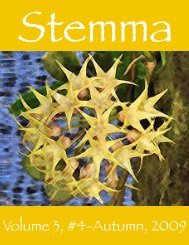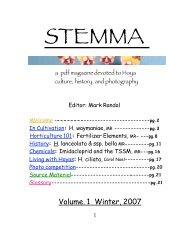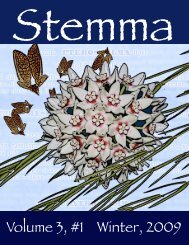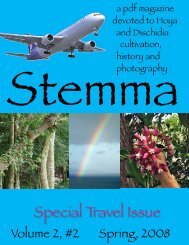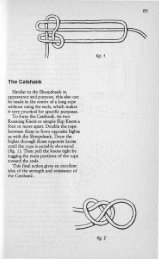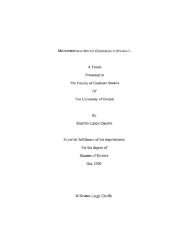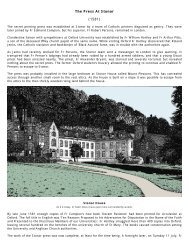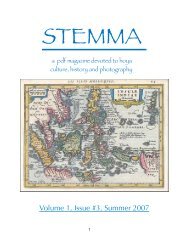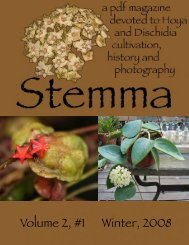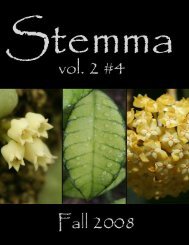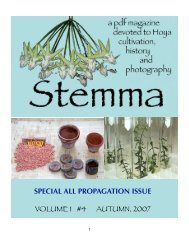Volume 3, Issue #2 - Cubits
Volume 3, Issue #2 - Cubits
Volume 3, Issue #2 - Cubits
Create successful ePaper yourself
Turn your PDF publications into a flip-book with our unique Google optimized e-Paper software.
Salient features:<br />
Pollinarium- the pollinia are club shaped, approximately twice as long as wide, and lack a pellucid edge.<br />
Translators and caudicles are twisted strongly. Corpuscula are relatively large, square.<br />
Corona- segments are usually relatively flat, acute at interior angle, rounded at exterior angle, with a median<br />
furrow on the upper surface. Underside of segments are broadly channeled. Overall the coronas of the species<br />
placed in genus Eriostemma are very similar morphologically to those of species grouped into Hoya section<br />
Amblyostemma, although these taxa are very different in most other respects. The lower portion of the<br />
corona is modified into a tall, broad staminal column which is buried in the corolla tissue.<br />
Corolla- waxy, thick textured. Usually rotate, occasionally reflexed (E. ciliata) to cup shaped (E. lauterbachii).<br />
Raceme- loosely convex.<br />
Species names currently thought to belong in this genus, validly transfered from genus Hoya:<br />
Eriostemma coronaria (Blume) D. Kloppenburg<br />
& Gilding (type)<br />
E. ciliata (Elmer ex. C. M. Burton) D. Kloppenburg<br />
& Gilding<br />
E. affinis (Hemsl.) D. Kloppenburg & Gilding<br />
E. lutea (Kostel.) D. Kloppenburg & Gilding E. madulidii (D. Kloppenburg) D. Kloppenburg<br />
& Gilding<br />
E. ariadna (Decne.) D. Kloppenburg & Gilding<br />
E. gigas (Schltr.) D. Kloppenburg & Gilding E. hollrungii (Warb.) D. Kloppenburg& Gilding*<br />
E. neoguineensis (Engl.) D. Kloppenburg &<br />
Gilding<br />
E. peekelii (Markgr.) D. Kloppenburg & Gilding E. purpurea (Blume) D. Kloppenburg & Gilding E. sussuela (Merr.) D. Kloppenburg& Gilding<br />
E. velutina (Wight) D. Kloppenburg & Gilding*<br />
* see appendix A, pg. 33<br />
Species names thought to belong to this genus, not technically transfered from genus Hoya:<br />
Hoya lauterbachii K. Schum. Hoya pulgarensis Elmer (Nom. Inv.) Hoya guppyi Oliver<br />
Taxonomic considerations: the species grouped here are widely recognized as constituting a distinct morphological<br />
group similar in many ways to the mass of species grouped within the genus Hoya. Opinions vary<br />
on whether this group should be included within genus Hoya as a section or recognized as a distinct, but<br />
closely related genus, as is genus Dischidia.<br />
While these species seem superficially similar to many species accepted in genus Hoya, there are several<br />
features which occur among Eriostemma species which rarely, if ever, occur among Hoya species. Of primary<br />
difference are the pollinaria of the species placed in genus Eriostemma, which have unique, twisted<br />
translators and caudicles and club shaped pollinia lacking a pellucid edge. The presence of a pellucid edge<br />
(a transparent zone on the outer margin of the pollinia through which pollen germination occurs) is a feature<br />
common to all accepted Hoya species, though rudimentary in some species (H. darwinii). The pollinaria of<br />
Eriostemma species also seems to have evolved a slightly different method of attaching themselves to the legs<br />
or probosces of visiting pollinators, a feature that further distinguishes these species from all known Hoya<br />
species (see pg. 28, this issue).<br />
Some other features which distinguish genus Eriostemma species are sometimes found in species accepted<br />
in genus Hoya, and so are not sufficient alone as distinguishing traits to demarcate genus Eriostemma. These<br />
features do provide corroborating evidence to the distinctness of this group of species. Among these “secondary”<br />
distinguishing traits are a terrestrial habit, densely wooly vegetative (and to some degree reproductive)<br />
parts, an extremely well developed staminal column hidden from casual viewing by virtue of being buried<br />
within the corolla, and thick, short follicles usually of a bluish-green color at maturity.<br />
24



